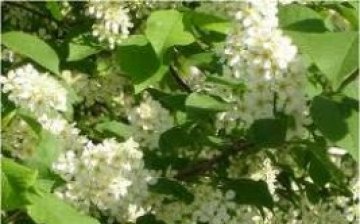White bird cherry
The white bird cherry is a deciduous tree or shrub of the Rosaceae family. Bird cherry is a fruit and ornamental crop.
Grafted seedlings begin to bear fruit at 3 or 4 years after planting, and seedlings - at 5-6 years. Bird cherry prefers lighted areas, loose, fertile, moist soils.
White bird cherry grows in damp forests, along river banks, in coastal bushes, in personal plots. There are about 20 types of bird cherry.
Bird cherry is a shrub or many-branched tree with a height of two to ten meters. Bird cherry has a dark gray, dull bark with lenticels and a characteristic odor. Leaves are elliptical, oblong, pointed, with reddish-brown glands. White bird cherry blossoms in May and June. It has fragrant, small, white flowers that are collected in long hanging axillary racemes. The fruits of the bird cherry are in the form of black shiny juicy drupes, with one stone. Fruits are odorless, highly astringent, bittersweet, ripen in August-September.
Bird cherry is a good honey plant. Bird cherry is propagated by seeds, layering, cuttings, root shoots and offspring, grafting. Bird cherry is planted at the boundaries of the site, on the slopes and near the reservoir. Bird cherry is used in decorative gardening due to its unpretentiousness, winter hardiness, abundant flowering, the presence of phytoncides in the leaves and bark. Bird cherry tolerates urban conditions well.
The fruits, bark, leaves and flowers of bird cherry are used in folk medicine. Bird cherry wood is a raw material for woodworking industry.



